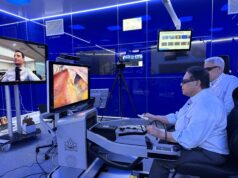
By Darren P Berman
The Melody transcatheter pulmonary valve (Medtronic), which received the CE mark in 2006 and FDA humanitarian device exemption approval in 2010, was recently granted FDA premarket approval. In this commentary, Darren P Berman explores the mid- and long-term data for the device.
Surgical correction in children with various forms of congenital heart disease (eg. tetralogy of Fallot, truncus arteriosis, variations of double outlet right ventricle and aortic valve disease requiring the Ross procedure) requires, in part, pulmonary valve replacement in the form of a right ventricular outflow tract (RVOT) conduit. These conduits have a finite lifespan before becoming dysfunctional in the form of stenosis, regurgitation, or a combination of both. Eventual conduit dysfunction necessitates a lifetime of conduit replacements, each with added morbidity and mortality risk.
However, the Melody valve was specifically designed to rehabilitate an existing dysfunctional RVOT conduit. Its design includes a platinum-iridium stent with a segment of valved bovine jugular vein sewn circumferentially within it. The valve is hand-crimped onto a 22F delivery system and percutaneously advanced inside the dysfunctional conduit. Once expanded, the valve (with or without previously placed bare metal stents) relieves obstruction and restores proper valve function.
The Melody valve is approved for persons who can accommodate the delivery system and with an existing conduit that was ≥16mm at the time of initial surgical implantation. Studies1–3 of the valve indicate that it is associated with good short- and long-term outcomes. For example, the valve has been consistently found to improve cardiac haemodynamic outcomes, New York Heart Association (NYHA) class, and quality of life in most patients. Also, medium to long-term follow-up data from the initial investigational device exemption (IDE) trial cohort demonstrated that the five-year freedom from valve explant was 92±3%.4
These data serve as the most comprehensive long-term follow-up data for the valve’s function and provide support for the idea that transcatheter pulmonary valve replacement restores function and prolongs the life of an existing RVOT conduit—helping to reduce the total number of reoperations patients will require over their lifetime.
Although the IDE trial did not review the use of the Melody valve to treat a dysfunctioning bioprosthetic valve placed in the RVOT position, this application of the Melody valve has been found to be associated with good short-term results.5 Further work to assess medium to long-term results of the Melody valve within RVOT bioprosthetic valves is ongoing. Additionally, the Melody valve also has been used in younger and smaller patients, some with smaller conduits than 16mm. There are some technical constraints—primarily related to the size of the delivery system—with using the valve in this cohort of patients, but these constraints are not insurmountable and the acute and short-term results in this cohort have been promising.6
Since the first transcatheter pulmonary valve replacement procedure was performed (more than 14 years ago), the era of transcatheter valve therapies has exploded upon us. The Melody valve is the first—and currently only—transcatheter pulmonary valve approved in the USA. More than 7,500 patients worldwide have received this technology. Next-generation valves (some of which have already been used outside of the USA) may allow less invasive valve replacement options for even more patients—helping to minimise the cumulative trauma patients must endure throughout their lifetime.
References
- Zahn et al. J Am Coll Cardiol 2009; 54: 1722–29.
- McElhinney et al. Circulation 2010; 122: 507–16.
- Armstrong et al. JACC Cardiovasc Interv 2014; 7: 1254–62.
- Cheatham et al. Data presented at American Heart Association Scientific Sessions 2014.
- Gillespie et al Circ Cardiovasc Interv 2012; 5: 862–70.
- Berman et al Circ Cardiovasc Interv 2014; 7: 142–48.
Darren P Berman, co-director, Interventional Cardiology, Nationwide Children’s Hospital, The Heart Center; assistant professor, Pediatrics, The Ohio State University, Columbus, USA










